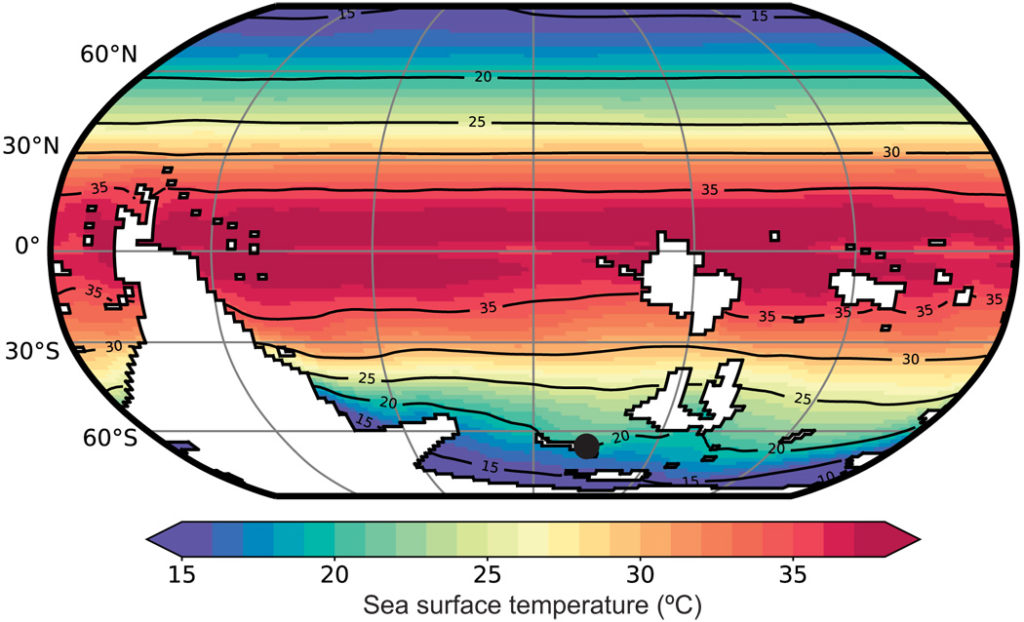@WFS,World Fossil Society,Riffin T Sajeev,Russel T Sajeev
An early Cambrian greenhouse climate
- Thomas W. Hearing et.al, Science Advances 09 May 2018:Vol. 4, no. 5, eaar5690,DOI: 10.1126/sciadv.aar5690
![Preservation of linguliformean brachiopods and Torellella from the Comley Limestones. (A) SEM and EDX analyses of pristine brachiopods preserve alternating compact and porous phosphatic laminae [(1) and (2)]; compact laminae comprise densely packed phosphatic spherules (3). Diagenetically sensitive elements, particularly Fe and Mg, are restricted to porous laminae (4). BSE, backscattered electron image. (B) SEM and EDX analyses of altered brachiopods may preserve laminar microstructure, but compact laminae phosphate has recrystallized to micrometer-scale prismatic crystals (3). Diagenetically sensitive elements indicative of alteration are found throughout altered specimens (4). (C) Pristine Torellella specimens comprise densely packed phosphatic spherules a few tens of nanometers in diameter (3).](http://www.worldfossilsociety.org/wp-content/uploads/2018/05/180206100338_1_900x600-3-1024x898.jpg)
Preservation of linguliformean brachiopods and Torellella from the Comley Limestones.
(A) SEM and EDX analyses of pristine brachiopods preserve alternating compact and porous phosphatic laminae [(1) and (2)]; compact laminae comprise densely packed phosphatic spherules (3). Diagenetically sensitive elements, particularly Fe and Mg, are restricted to porous laminae (4). BSE, backscattered electron image. (B) SEM and EDX analyses of altered brachiopods may preserve laminar microstructure, but compact laminae phosphate has recrystallized to micrometer-scale prismatic crystals (3). Diagenetically sensitive elements indicative of alteration are found throughout altered specimens (4). (C) Pristine Torellella specimens comprise densely packed phosphatic spherules a few tens of nanometers in diameter (3).

Early Cambrian mean annual SSTs, modeled by the FOAM GCM.
The simulation was run under present-day orbital configurations with a CO2-equivalent greenhouse gas forcing of 32 PAL (see Materials and Methods and fig. S4). Black spot marks the position of our δ18Ophos data on Avalonia.
The oceans of the early Cambrian (~541 to 509 million years ago) were the setting for a marked diversification of animal life. However, sea temperatures—a key component of the early Cambrian marine environment—remain unconstrained, in part because of a substantial time gap in the stable oxygen isotope (δ18O) record before the evolution of euconodonts. We show that previously overlooked sources of fossil biogenic phosphate have the potential to fill this gap. Pristine phosphatic microfossils from the Comley Limestones, UK, yield a robust δ18O signature, suggesting sea surface temperatures of 20° to 25°C at high southern paleolatitudes (~65°S to 70°S) between ~514 and 509 million years ago. These sea temperatures are consistent with the distribution of coeval evaporite and calcrete deposits, peak continental weathering rates, and also our climate model simulations for this interval. Our results support an early Cambrian greenhouse climate comparable to those of the late Mesozoic and early Cenozoic, offering a framework for exploring the interplay between biotic and environmental controls on Cambrian animal diversification.
@WFS,World Fossil Society,Riffin T Sajeev,Russel T Sajeev



 May 11th, 2018
May 11th, 2018  Riffin
Riffin  Posted in
Posted in  Tags:
Tags: 